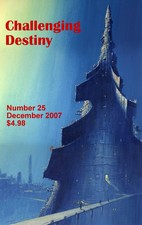


Reviews Home
Columns
Fiction by Title
Fiction by Author
Nonfiction
Movies by Title
Movies by Rating
Audio
Games
Moonlight and Vines, Charles de Lint, TOR, 1999, 384 pp.
Moonlight and Vines is Charles de Lint's most recent Newford collection, following Dreams Underfoot and The Ivory and the Horn. All of the familiar characters of Newford are here, although most of the core friends no longer get their own story; thankfully, the new cast is just as fascinating. As usual, it's always a good feeling to meet up with Jilly or Geordie, even if they are only secondary to the main narrative. De Lint continues to expand Newford's literary territory with confidence and a good deal of grace, and his prose is a joy to read. Not particularly flashy, yet not completely invisible.
Moonlight and Vines seems to have more of an emphasis on relationships than the previous two books. The story from which the title of the book is derived, "Held Safe by Moonlight and Vines," is a wonderfully moving account of a woman named Lilli and a sudden romance in her life. She is hanging out a good deal in the cemetery, for her own personal reasons, and becomes aware that a man is following her. Then a drug deal goes wrong, and this mysterious man protects her -- it is her childhood friend, Alex, who finally admits that he has been in love with Lilli his whole life. This plot summary reads like my worst nightmare, but de Lint somehow manages to create something true and lacking false sentimentality.
The story of Saskia bookends this collection. In "Saskia," we first find out about Saskia, who is not quite human, and about the man who loves her. "The Fields Beyond the Fields" closes the collection and here de Lint depicts post-relationship trauma in all its hurt and confusion. Many of de Lint's romances concern themselves with non-Hollywood relationships, as with "In This Soul of a Woman," where an exotic dancer named Nita who meets Imogen (who turns out to be a vampire). "Passing" deals with lesbian characters (something with which Hollywood still has a few odd problems), and a girl named Nina who claims to be a sword girl. "The Invisibles" is one of de Lint's tragic love stories, where things don't work out according to plan, not by miles and miles.
Another theme that I noticed running through this collection more so than the previous two is the first encounter with magic. Dreams Underfoot had "Ghosts of Wind and Shadow" where a main character ends up institutionalized because of her refusal to see the magic around her. In Moonlight and Vines, de Lint spins several variations on this theme. I've already mentioned "The Invisibles," where the main character won't believe in the invisibility of friendless people until it happens to him. "In the Quiet After Midnight" is a strange and frightening story about a woman named Hannah who meets someone in a church late at night; she desperately tries to deny her own guesses about this mysterious person. "The Pennymen" is perhaps most similar to "Ghosts of Wind and Shadow." Eliza owns an art gallery and starts seeing Pennymen around the place, Pennymen being men the size of pennies and who appear to be pennies if you are looking at them. Eliza's roommate Sarah is terrified of Eliza's tales; Sarah's mother "went crazy" many years ago and so Sarah is protective of her sanity.
De Lint again uses the fictional setting of Newford to address pressing issues of social justice. As a refreshing change from other works of fantasy, the Newford stories are often about or told by those who are marginalized by society. We never see the bigwigs of the city; the view of Newford is ground up, and it's bold and profoundly subversive. It's fascinating how de Lint addresses various evils and ills of our society, all in a non-dogmatic way with fiction that keeps us reading. However, there are two vigilante stories in Moonlight and Vines that are somewhat problematic. In the first, "In the Land of the Unforgiven," Joe Cray has just gotten out of jail, after having served his time for murder. Joe finds out about a child-slavery ring, and a cop named Dan lets Joe get away with (if not actively encouraging) the murder of the ring-leader. This murder is somehow portrayed as different than the one Joe served time for. "China Doll" is a revenge story, and its two main characters, Coe and China, are dead. That doesn't stop them from taking revenge on the gang led by Jimmy, Coe's former colleague in a top-secret U.S. assassination squad. In order to give the dead (themselves) peace, Coe and China turn Jimmy in to the police. These two stories are about people whose patience with evil is stretched to the breaking point, and while the motivations were believable, I was uneasy with the portrayal of these people as guiltless heroes.
Moonlight and Vines has some stories that are largely unclassifiable. "My Life as a Bird" is about a woman named Mona who creates the comic book of the title. She loans some money to a leprechaun named Nacky Wilde, who is now beholden to her, and proceeds to make her life miserable with his extreme sarcasm and intermittent invisibility. The story is a hoot, and Nacky might be the most sarcastic character I've ever encountered. "Crow Girls" is a warm-up for Someplace to Be Flying, and like that novel, it has an odd plot and is compulsively readable.
Moonlight and Vines is highly recommended, and is just as good a place to begin discovering Newford as the other short story collections. The stories are filled with magic, personal pain, and believable epiphanies. No cheap emotion here.
Last modified: February 16, 2000
Copyright © 2000 by James Schellenberg (james@jschellenberg.com)

Buy back issues of Challenging Destiny online from:
For the latest information on availability: Where Can You Buy Challenging Destiny?